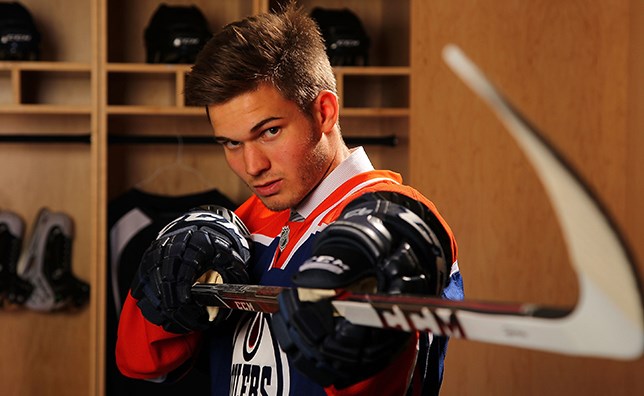features star power on defence and in net, with Olli Juolevi and Thatcher Demko making their first appearance at the prospect showcase. Where the roster is lacking, however, is at forward.
This is a bit understandable when you consider their top forward prospect, Brock Boeser, has already started his school year in the NCAA, as has Adam Gaudette, while Jake Virtanen is understandably skipping the tournament. It will still be interesting to see 2016 picks like Brett McKenzie and Jakob Stukel make their debuts in a Canucks jersey, but a lot of the intrigue at forward for the Canucks will lie with the unsigned and undrafted invitees.
Six of the eight invitees on the Canucks roster are forwards, plus on defence and in net. Five of those six forwards also attended the Canucks’ development camp in the summer: , , , , and .
D’Aoust, with his 98 points last season, is one to watch, but the tiny Maksimovich and hard-working Moynihan are worth keeping an eye on as well. We’ll also get a closer look at Michael Carcone, after he was an invitee at development camp.
But the most intriguing invitee of the bunch is the only one that didn’t attend the Canucks’ development camp: Marc-Olivier “Marco” Roy. While I wrote about the during the summer, Roy has yet to receive an invitee profile.
– Centre/Left Wing
6’0″ – 175 lbs – November 5, 1994 (21)
Boisbriand, QC
Bakersfield Condors (42-8-12-20)
Unlike the other invitees, Roy isn’t exactly undrafted. He was selected in the second round by the Edmonton Oilers in the 2013 draft, 56th overall. But he is unsigned, as the Oilers chose not to sign him to an entry-level contract and he re-entered the 2015 draft and slipped right through without being picked.
After that, he ended up back in the Oilers’ organization, signing a contract with their AHL affiliate, the Bakersfield Condors, where he had a respectable, if unremarkable, rookie season, putting up 20 points in 42 games.
So what happened? How did Roy go from being a second-round pick to an unsigned invitee in just a few short years?
Long story short: he had a couple injuries and his production in Junior stagnated. But lots of prospects disappoint after their draft year and still get an opportunity. The difference for Roy may be that there was a change in management in Edmonton, as Craig MacTavish, who was in charge when Roy was drafted, was replaced by Peter Chiarelli just a couple months before Roy went back into the draft.
In the year he was drafted, Roy was an understandable pick in the second round. He was coming off 29 goals and 67 points in 65 games, as well as 19 points in 15 playoff games. Couple that with speed, grit, and a reputation for two-way play and 56th overall seems about right.
At the time he was drafted, prospects writer Corey Pronman , but questioned his consistency and suggested he needed to add weight to his 6’0” frame. Regrettably, the latter issue still seems to be a problem, as Roy is listed as just 175 lbs, which is lighter than Jordan Subban, who is at least three inches shorter than Roy.
Scott Reynolds at Oilers blog Copper N Blue was . He put together a list of comparable players and noted that “none of the seventeen guys with a similar draft and scoring profile have become NHL players,” though one of those, Devante Smith-Pelly, has since found his NHL niche and another, Michael Bournival, seemed to be on track until a concussion derailed him.
After getting drafted, that caused him to miss six weeks. After he came back, he suffered a concussion and missed another six weeks. When he got back for good, he found his role on the team lessened as the team became one of the best in the QMJHL in his absence. He finished with 35 points in 39 games.
Heading into his final year of Junior, he was traded to the Quebec Remparts and again found himself playing a smaller role, with the likes of Dmytro Timashov and Adam Erne leading the team. He played minimally on the power play, with 23 of his 26 goals with the Quebec Remparts coming at even-strength. That wasn’t the case in his draft year, when he tallied 13 goals and 13 assists on the power play.
He once again finished the season below a point-per-game, with 50 points in 59 games. He made his mark, however, at the Memorial Cup, tallying 5 points in 5 games. McKeen’s Hockey saw him as , noting “Roy was one of the few Quebec forwards who took the ice with energy every shift.”
It’s his speed that makes me think Roy could have an NHL future. Craig Button suggested last year that and that his ability to play and think the game at high speed gave him potential. He’s also versatile, able to play at both centre, where he can best utilize his two-way game and speed on the backcheck, and left wing, where his speed in transition offensively is most useful.
Roy looks like a potential reclamation project for a team looking to improve their prospect depth at forward, particularly one that has been focussing on team speed and grit. Lo and behold, the Â鶹´«Ă˝Ół»Canucks are just such a team.
The Young Stars Tournament is an excellent opportunity for the 21-year-old Roy to make an impact, particularly when the Canucks don’t have many noteworthy forwards on their Young Stars Roster. He’s older and more experienced than most of the players he’ll be facing and playing with, putting him in a good position to earn an invite to the Canucks’ main camp.
Ěý



